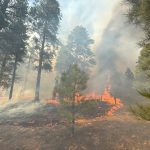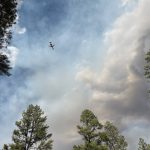
$2.1 billion in ARPA funds sits idle
WINDOW ROCK
With $2.1 billion in Navajo ARPA funds in the bank, mums the word on how entities can access any of those monies as the president’s, speaker’s, and the controller’s offices haven’t clearly publicized the process and requests for information go unanswered.
Even though the framework for spending Navajo American Rescue Plan Act funds was set up in Navajo Nation Council resolution and signed by President Jonathan Nez on Aug. 2, confusion remains as to what happens next.
How and when will ARPA funds will be allocated, or where will RFPs for approved projects and services contracts be posted for bidding?
The Council resolution created the ARPA Navajo Nation Fiscal Recovery Fund and a general expenditure authorization process, including procurement and oversight guidelines.
The bill waived certain provisions of the Appropriations Act, authorized emergency procurements and authorized a Fiscal Recovery Fund Office under the president’s office.
However, that office, intended to be a “clearinghouse” and vetting entity for ARPA proposals, that will “educate the public,” and oversee spending and completion of projects and services is nowhere near up and running, by all accounts.
The bill’s sponsor, Delegate Carl Slater, did confirm on Monday that any money that is going to be spent has to first be approved by a two-thirds vote of Council and signed by the president, which means all expenditure proposals will have to be put into legislation.
As of now, there are no additional ARPA legislations in the pipeline and $2.1 billion sits in the Navajo Nation ARPA Fiscal Recovery Fund account unspent.
U.S. Treasury disbursements received
On Tuesday, Washington Office Director Santee Lewis confirmed that the Navajo Nation received its first allocation of $1.86 billion in ARPA funds on May 28, based primarily on certified enrollment data, and an additional $217.9 million was received on Aug. 16, based on tribal employment data.
“At this time, we do not expect any additional Fiscal Recovery Funds to be disbursed from treasury,” Lewis said, indicating the $2.1 billion is the final total that is available to the Nation.
Suffice it to say, what has been referred to countless times as “a once-in-a-lifetime opportunity” for the Navajo Nation government to help its people recover from the coronavirus pandemic, seems to be completely stalled.
ARPA funds are intended to respond to the COVID-19 public health emergency and its negative economic impacts, including assistance to households, small businesses, nonprofits, and aid to impacted industries such as tourism and hospitality.
The act also allows for premium pay to essential workers, necessary investments in water, sewer and broadband infrastructure, and replaces lost revenue for local governments to fortify public services.
Navajo Nation funds must be obligated or incurred by Dec. 31, 2024, and projects must be completed by Dec. 31, 2026.
B & F approves application
Per Council’s resolution, one of the first action items necessary for ARPA projects to get started was for the Budget and Finance Committee to pass legislation to establish the ARPA FRF application procedures, forms, and expenditure templates, which was accomplished with a Sept. 1 resolution.
That legislation, which can be viewed online, includes quite a bit of information on how “Navajo Nation government units, non-certified chapters, certified chapters, Navajo Nation-owned entities, and external entities” are supposed to submit proposals and apply for ARPA funds.
However, none of the instructions have been shared with the public.
Council Speaker Seth Damon did not respond when asked why that has not happened yet.
Jared Touchin, communications director for the president’s office, said the office is working with the legislative branch to “finalize the process,” that will be presented to the Council “in the next week or two.”
In the meantime, this reporter found out that the application forms generated the Budget & Finance Committee resolution can be found on the Office of Management and Budget website.
Another important requirement included in Council’s resolution was for the president’s office to present a plan of operation for the Navajo Nation Fiscal Recovery Fund Office, tasked with administering the ARPA project, to the Naabik’iyati Committee for review.
As of yet, this has not happened.
In response to a request for information to the president’s office as to how the hiring process to staff the office was working, Touchin again said, “The executive branch will be reporting the status of the office to the members of the Council in the next week or two….”
Council’s resolution clearly states that the “OPVP shall only contract with qualified and experienced Navajo-owned enterprises/authorities/corporation or businesses to assist in the implementation, management and monitoring of FRF funds.”
However, evidently, Dibble Corp., an engineering firm out of Phoenix, has already been assisting the president’s office with putting together the executive branch project list.
“I’m helping to put together some of the plans,” Dibble Corp Transportation Vice President Tim Wolfe said on Monday.
Wolfe said the company was brought in to assist the president’s office because of its ongoing work as a consultant for the Navajo Division of Transportation but referred this reporter back to the president’s office for additional information.
In response, Touchin told Navajo Times, “Dibble is providing technical assistance for the compilation of project listings in accordance with federal guidelines.”
Back in early August, in a joint leadership meeting, Nez and Chief of Staff Paulson Chaco shared their office’s ARPA priorities, including broadband, water/wastewater, housing, bathroom additions, education, health, social services, economic development and tourism.
However, no proposed project list with dollar figures had been provided at that time.
On Aug. 16, Touchin told the Times that Chaco, division directors, and others were “in the process” developing a project listing for a proposed expenditure plan, which would be shared with Council, but that has not happened yet either, at least in an official capacity.
According to several sources, who wished to remain anonymous, the president’s office now has a list of around 900 to 1,000 proposed projects to be funded through ARPA.
On Tuesday, Touchin confirmed that “previously,” a comprehensive project listing was developed that includes over 9,000 projects at a cost of more than $20 billion.
“I am trying to obtain an electronic file for this – please note that this is a general list and not the ARPA project list from the executive branch,” Touchin said.
‘We don’t know’
Within 30 days of the effective date of Council’s resolution, the controller’s office was also supposed to have set up an online “accountability platform” on the its website that would enable the public to view financial transactions including checks, deposits, fund transfers, contracts and other supporting documentation.
That hasn’t happened yet either and Acting Controller Elizabeth Begay did not respond to an email asking when the platform would be going live.
Non-government entities, including nonprofits and small businesses, have also been sitting on the sidelines waiting for any information about how to apply, bid for, or submit proposals for ARPA project funds.
Al Henderson, secretary-treasurer for the Dineh Chamber of Commerce, said they’ve heard nothing new about ARPA funding.
“We’re in a quiet period….” Henderson said. “Everybody is looking back and forth, asking one another, scratching their heads, and throwing their hands up!”
Charles-Newton said she was concerned that Navajo small businesses were being left in the dark.
“There hasn’t really been an announcement or any information coming out of the president’s office or the speaker’s office,” she said. “We don’t even know what the plan is.”
Slater said he had asked Chaco for an update on progress for setting up the office and the controller’s accountability platform but had not gotten any solid answers.
The one thing we do know for sure is 10% of the Navajo ARPA funds, or approximately $186 million, was allocated in the Council resolution for government administrative support and regulatory services in a $162/$18 million formula to the president’s and speaker’s offices, respectively.
The president’s office is responsible for apportioning $162 million among executive branch programs and offices administering ARPA funds and Speaker Seth Damon and the Naabik’iyati’ Committee will distribute $18 million amongst legislative branch programs.
Unless something changes, another given, per Council’s resolution, is that unfinished CARES Act projects, and Sihasin and UUFB fund projects that qualify will be reimbursed with ARPA funds, but those exact figures are not yet available.
Touchin said the Department of Justice is still vetting those project lists to ensure they comply with federal guidelines for the use of ARPA funds.
Direct relief for the people
One big question that many Diné have been patiently waiting for answers to is whether there will be another round of direct financial assistance to the people through ARPA as with the CARES Hardship Program.
Council’s resolution states that financial assistance to enrolled Navajo Nation members will be limited to 10% of the total ARPA funds received by the Nation, which at this point would be about $200 million.
If the approximately 400,000 enrolled Navajos applied, payments would be around $500 per person.
Back in early June, Charles-Newton and Delegate Vince James submitted a request for a bill proposing to use ARPA funds to give every enrolled Diné adult $2,000 and every child $1,000 in direct financial assistance, which would cost an estimated $600 million.
But apparently that legislation is now dead in the water because of the new processes that were approved by the Budget and Finance Committee.
Charles-Newton said that she just recently found from the Office of Legislative Counsel that even delegates have to fill out the new ARPA application forms in order to drop legislation proposing appropriation of ARPA funds.
“I was told, ‘You can’t just drop legislation, you have to abide by the processes Budget and Finance approved for ARPA funding,’” she said. “I thought it was going to be as simple as with the CARES Act, but this is going to be a little bit more difficult….”
This added step might explain why more legislation has not been finalized yet, and why more delegates did not respond to a request for information on ARPA bills they are planning to introduce.
It also suggests that even the president’s office will have to submit application forms for the giant executive branch project list to get it into the legislative pipeline.
Regardless, Charles-Newton said her goal is to try to get her ARPA application processed by the Council’s fall session so that a new round of ARPA direct assistance “payments to the people” can be sent out by Thanksgiving.
As a public service, the Navajo Times is making all coverage of the coronavirus pandemic fully available on its website. Please support the Times by subscribing.
How to protect yourself and others.
Why masks work. Which masks are best.
Resources for coronavirus assistance








 Highway 264,
Highway 264, I-40, WB @ Winslow
I-40, WB @ Winslow